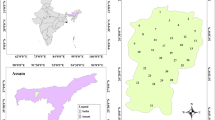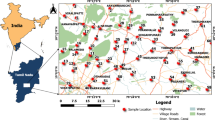Abstract
Very high uranium concentrations of ⁓3000 μgL−1 or more have been found in groundwater held in the granitic aquifers of four villages in eastern Karnataka, India. The highest uranium concentration was 8649 μgL−1 (calculated 218.7 BqL−1) and a maximum radon activity of 101.4 BqL−1. The ingestion doses of uranium for males and females of all age groups are very much higher compared to the corresponding dose calculated for World Health Organization and Atomic Energy Regulatory Board recommended concentrations of 30 and 60 μgL−1for drinking water. It is therefore recommended that alternative sources for drinking water need to be made to meet United Nations Sustainable Development Goals 3 and 6 to ensure good health from safe drinking water.



Similar content being viewed by others
Data availability
The authors have no financial or proprietary interests in any material discussed in this article.
References
World Health Organization (1963) International standards for drinking-water
Indian Standard Specification for Drinking Water (1983) IS: 10500
World Health Organization (2011) Guidelines for drinking-water quality. WHO Chron 38(4):1–178
World Health Organization (2012) Uranium in drinking water. Background document for development of WHO guidelines for drinking-water quality. WHO, Geneva, pp 1–21
Sahoo SK, Jha VN, Patra AC, Jha SK, Kulkarni MS (2020) Scientific background and methodology adopted on derivation of regulatory limit for uranium in drinking water–a global perspective. Environ Adv 2:100020
AERB (2004) Limits on uranium in drinking water, atomic energy regulatory board of India, Mumbai, AERB/VC/16/2004/80/373
Virk HS (1997) Uranium and radon surveys in western Himalaya. Curr Sci 73(6):536–538
Central Ground Water Board (CGWB) report (2020) Uranium occurrence in shallow aquifers in India. http://cgwb.gov.in/WQ/URANIUM_REPORT_2019-20.pdf
Sahoo SK, Jha SK, Jha VN, Patra AC, Kulkarni MS (2021) Survey of uranium in drinking water sources in India: interim observations. Curr Sci 120(9):1482–1490
Coyte RM, Jain RC, Srivastava SK, Sharma KC, Khalil A, Ma L, Vengosh A (2018) Large-scale uranium contamination of groundwater resources in India. Environ Sci Technol Lett 5(6):341–347
Srinivasan R, Pandit SA, Karunakara N, Deepak Salim K, Sudeep Kumara M, Kumar R, Khatei G, Ramkumar KD (2021) High uranium concentration in groundwater used for drinking in parts of eastern Karnataka. India Curr Sci 121(11):1459
Markich SJ (2002) Uranium speciation and bioavailability in aquatic systems: an overview. Sci World J 2:707–729. https://doi.org/10.1100/tsw.2002.130
Kimura T, Serrano GJ, Nakayama S, Takahashi K, Takeishi H (1992) Speciation of uranium in aqueous solutions and in precipitates by photoacoustic spectroscopy. Radiochim Acta 58(1):173–178
Deshmukh P, Sar SK, **dal MK, Ray T (2023) Magnetite based green bio composite for uranium exclusion from aqueous solution. J Radioanal Nucl Chem 332:297–310
Haynes WM (Ed) (2014) Section 4–properties of the elements and inorganic compounds, CRC Handbook of chemistry and physics (95th edn). CRC Press, Boca Raton.https://doi.org/10.1201/b17118
Degu Belete G, Alemu Anteneh Y (2021) General overview of radon studies in health hazard perspectives. J Oncol. https://doi.org/10.1155/2021/6659795
Agency for Toxic Substances and Disease Registry (ATSDR) (2013) Toxicological profile for uranium. U.S. Department of Health and Human Services, Public Health Service, Atlanta
Sanjon EP, Maier A, Hinrichs A, Kraft G, Drossel B, Fournier C (2019) A combined experimental and theoretical study of radon solubility in fat and water. Sci Rep 9(1):10768. https://doi.org/10.1038/s41598-019-47236-y
Chikkballapur district profile (2023) https://chikkaballapur.nic.in/en/demography/. Access on 5th April 2023
Kolar district profile (2023) https://kolar.nic.in/en/demography/. Access on 5th April 2023
Ramakrishnan M, Vaidyanadhan R (2008) Geology of India. Geological Society of India Publications, vol 1, p 557
Moyen JF, Martin H, Jayananda M, Auvray B (2003) Late archean granites: a typology based on Dharwar craton (India). Precabrian Res 127:103–123
Krogstad EJ, Hanson GN, Rajamani V (1991) U-Pb ages of zircon and sphene for two gneiss terranes adjacent to the Kolar Schist Belt, South India: evidence for separate crustal evolution histories. J Geol 99(6):801–815
Nandy J, Dey S, Heilimo E (2019) Neoarchaean magmatism through arc and lithosphere melting: evidence from eastern Dharwar Craton. Geol J 54(5):3148–3166. https://doi.org/10.1002/gj.3498
Sarma SD, Parashuramulu V, Santosh M, Nagaraju E, Ramesh Babu N (2020) Pb–Pb baddeleyite ages of mafic dyke swarms from the Dharwar Craton: implications for Paleoproterozoic LIPs and diamond potential of mantle keel. Geosci Front 11(6):2127–2139. https://doi.org/10.1016/j.gsf.2020.05.014
Goswami S, Maurya VK, Tiwari RP, Swain S, Verma MB (2019) Structural analysis of T. Sundupalle greenstone belt and surrounding granitoids, Andhra Pradesh, India. Arab J Geosci 12:1–18. https://doi.org/10.1007/s12517-019-4793-2
Kumar P. Senthil (2001) Radioelemental distribution in the Dharwar craton, south India: Implications for the evolution of the upper continental crust and heat generation in the craton (Ph. D. thesis, Osmania Univ., Hyderabad, India, p 218)
International Atomic Energy Agency (2010) Analytical methodology for the determination of radium isotopes in environmental samples. IAEA
Karunakara N, Yashodhara I, Sudeep Kumara K, Tripathi RM, Sanjeev MN, Sonal K, Chougaonkar MP (2014) Assessment of ambient gamma dose rate around a prospective uranium mining area of South India–a comparative study of dose by direct methods and by soil radioactivity. J Results Phys 4:20–27
Al-Azmi D, Sudeep Kumara MP, Mohan NK (2019) Gamma dose rates in the high background radiation area of Mangalore region, Results. Radiat Prot Dosim 184(3–4):290–293
Mohan MP, D’souza RS, Nayak SR, Kamath SS, Shetty T, Kumara KS, Karunakara N (2018) A study of temporal variations of 7Be and 210Pb concentrations and their correlations with rainfall and other parameters in the South West Coast of India. J Environ Radioact 192:194–207
Mohan MP, D’Souza RS, Nayak SR, Kamath SS, Shetty T, Kumara KS, Karunakara N (2019) Influence of rainfall on atmospheric deposition fluxes of 7Be and 210Pb in Mangaluru (Mangalore) at the Southwest Coast of India. Atmos Environ 202:281–295
Yashodhara I, Karunakara N, SudeepKumar K, Murthy R, Tripathi RM (2011) Radiation levels and radionuclide distributions in soils of the gogi region, a proposed uranium mining region in north Karnataka. Radiat Prot Environ 34(4):267
Yashodhara I, Sudeep Kumara K, Tripathi RM, Karunakara N (2012) Activity concentrations of 226Ra and 238U in water samples and estimation of radiation dose around the proposed uranium mining region in Gogi. In: 19th national symposium on radiation physics (NSRP-19), pp 525–528
Raghavayya M, Iyengar MAR, Markose PM (1980) Estimation of Radium-226 by emanometry. Bull Radiat Prot 3:11–14
IAEA Safety Standards (2011) Radiation protection and safety of radiation sources: international basic safety standards, p 471
UNSCEAR (United Nation Scientific Committee on the effect of Atomic Radiations) (2000) Ionizing radiation. Sources and biological effects report to the general assembly with scientific annexes. New York, United Nations, p 659
Reserve Bank of India (RBI) (2020) https://rbi.org.in/Scripts/PublicationsView.aspx?id=20000
Radiation Risk in Perspective (2019) Position statement of the heath physics society. https://hps.org/documents/radiationrisk.pdf
UNSCEAR (United Nation Scientific Committee on the effect of Atomic Radiations) (2016) Sources, effects and risks of ionizing radiation. New York, United Nations p 512. https://www.unscear.org/docs/publications/2016/UNSCEAR_2016_Report-CORR.pdf
Acknowledgements
The authors are indebted to Prof. S. K. Satheesh for his support and encouragement. The authors are thankful to Mrs. Kavitha Devi Ramkumar for her help in the preparation of illustrations.
Funding
The authors have no relevant financial or nonfinancial interests to disclose.
Author information
Authors and Affiliations
Corresponding authors
Ethics declarations
Conflict of interest
The authors have no competing interests to declare that are relevant to the content of this article.
Ethical approval
All authors certify that they have no affiliations with or involvement in any organization or entity with any financial interest or nonfinancial interest in the subject matter or materials discussed in this manuscript.
Additional information
Publisher's Note
Springer Nature remains neutral with regard to jurisdictional claims in published maps and institutional affiliations.
Rights and permissions
Springer Nature or its licensor (e.g. a society or other partner) holds exclusive rights to this article under a publishing agreement with the author(s) or other rightsholder(s); author self-archiving of the accepted manuscript version of this article is solely governed by the terms of such publishing agreement and applicable law.
About this article
Cite this article
**dal, M.K., Pandit, S.A., Karunakara, N. et al. High uranium dose from the groundwater in a granitic terrain in the eastern part of Karnataka, India. J Radioanal Nucl Chem 333, 2905–2913 (2024). https://doi.org/10.1007/s10967-023-09053-6
Received:
Accepted:
Published:
Issue Date:
DOI: https://doi.org/10.1007/s10967-023-09053-6




